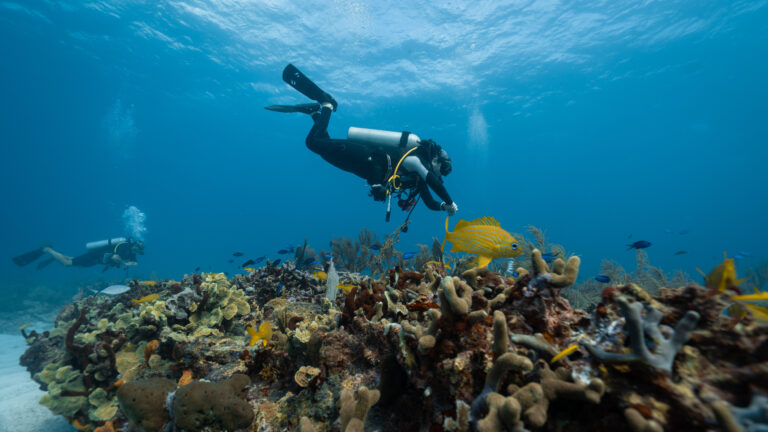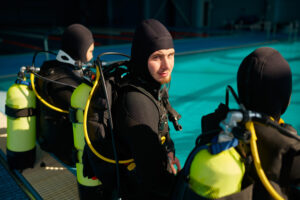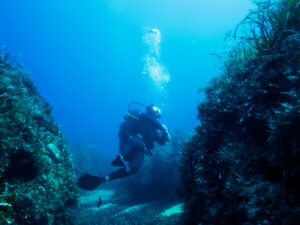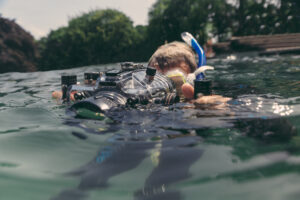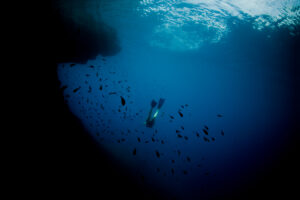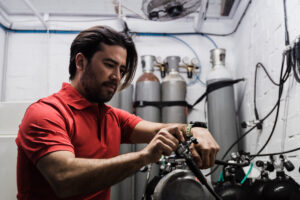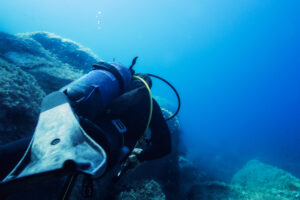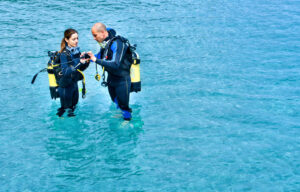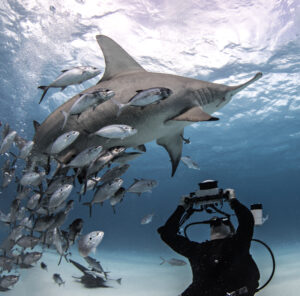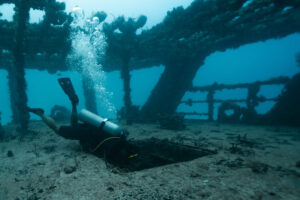What is Free Flow?
Scuba diving is an immersive underwater experience that offers divers a glimpse into the unique marine environment. To safely navigate these depths, divers rely on specialized equipment, with one of the most critical components being the demand regulator. This device controls the flow of air from the tank to the diver, ensuring they receive air at the appropriate pressure. However, like any mechanical equipment, the regulator can malfunction, and one specific issue is known as “free flow.” This malfunction can result in continuous air flow from the regulator, regardless of the diver’s input, potentially depleting the air supply quickly and leading to serious safety concerns.
Free flow occurs when the regulator’s valve becomes stuck in an open position, allowing air to flow uncontrollably. Instead of the regulator providing air only when the diver inhales, it releases a constant stream of air. If this problem isn’t resolved promptly, the diver’s air supply can be quickly exhausted, forcing a premature ascent and possibly increasing the risk of decompression sickness or other health complications. Understanding the causes, consequences, and solutions for free flow is essential for any diver to maintain safety during a dive.
Causes of Free Flow
Free flow in a scuba regulator can arise from several different factors, most of which are related to the wear and tear of the equipment, environmental conditions, and improper maintenance. It is essential for divers to be aware of these causes to mitigate the risk of encountering this issue during a dive.
Wear and Tear
Over time, diving equipment, especially demand regulators, is subjected to significant wear and tear due to repeated use and exposure to harsh underwater environments. The regulator consists of several small moving parts that work together to control the flow of air from the tank to the diver. As these parts age, they can become worn or damaged, leading to issues such as the valve becoming stuck in the open position, resulting in free flow. Corrosion, particularly from exposure to saltwater, can exacerbate this problem. Salt deposits and other debris may accumulate inside the regulator, interfering with its smooth operation. Without regular maintenance, these minor issues can eventually lead to a malfunction that poses serious risks to the diver.
In addition to corrosion, the repetitive stress placed on the regulator’s components during dives can cause seals, diaphragms, and springs to degrade. Even with careful usage, the mechanical parts inside the regulator will naturally wear out over time, making it increasingly susceptible to malfunction. Regular inspection and timely replacement of worn parts are essential for preventing free flow caused by wear and tear. Divers who neglect regular servicing may face unexpected equipment failure, often at critical moments underwater, highlighting the importance of proper care and attention to their gear.
Cold Water
Cold water environments present unique challenges to diving equipment, particularly the demand regulator. One of the primary risks when diving in cold water is the formation of ice crystals inside the regulator. This phenomenon occurs when the air from the tank is depressurized as it passes through the first stage of the regulator. The rapid drop in pressure causes the surrounding temperature to plummet, sometimes leading to freezing, especially in water temperatures below 10°C (50°F). When ice forms inside the regulator, it can cause the valve to freeze open, resulting in a continuous flow of air, or free flow.
Regulators that are not designed for cold water diving or those lacking environmental sealing are particularly vulnerable to this issue. Environmental sealing prevents water from entering the regulator’s internal mechanism, reducing the chance of freezing. However, even with proper gear, divers must remain cautious when diving in extremely cold conditions. In such situations, free flow can quickly deplete the air supply, making it essential for divers to be prepared and equipped with gear suitable for cold water diving.
Improper Maintenance
Improper or irregular maintenance is one of the most common causes of free flow malfunctions in scuba regulators. A regulator that is not cleaned, serviced, or inspected according to manufacturer recommendations can become prone to failure over time. Accumulated debris, salt, sand, or other contaminants can obstruct the internal mechanisms, causing the valve to stick or malfunction. When parts inside the regulator are worn out or damaged, the risk of free flow increases, particularly if those parts are not replaced in a timely manner. Regular servicing by a qualified technician ensures that worn components are replaced, cleaned, and properly calibrated, helping prevent malfunctions during a dive.
In addition to professional servicing, divers must also take responsibility for the care of their equipment between dives. This includes thoroughly rinsing the regulator in fresh water after each dive to remove salt and debris, and ensuring the equipment is properly dried and stored. Diving gear that is not stored correctly can deteriorate faster, increasing the likelihood of issues such as free flow. Following a consistent maintenance routine is crucial for ensuring the longevity and reliability of the regulator, ultimately helping to prevent accidents underwater.
Manufacturing Defects
While rare, manufacturing defects can sometimes cause free flow malfunctions in scuba regulators. A defect may occur during the production process, resulting in faulty components that do not operate as intended. For example, a misaligned valve or subpar materials could cause the regulator to fail, leading to continuous air flow. Even though most diving equipment is subjected to rigorous quality control tests before leaving the factory, there is always a small chance that a defective item might reach consumers. Such defects can pose a significant risk to divers, as they may not become apparent until the regulator is in use underwater.
To minimize the risk of encountering manufacturing defects, divers should purchase equipment from reputable manufacturers and retailers. High-quality brands are more likely to offer reliable products, and many provide warranties or quality guarantees to protect consumers in the event of a defect. It’s also important to thoroughly test any new equipment before using it on a dive. By doing so, divers can ensure that their gear functions correctly, reducing the likelihood of a malfunction during a dive.
Consequences of Free Flow
The consequences of a free flow malfunction can be severe, especially if the issue is not addressed promptly during a dive. When a regulator begins to free flow, the diver’s air supply is rapidly depleted, potentially leading to dangerous situations that require immediate attention.
Rapid Air Depletion
The primary consequence of free flow is the rapid depletion of a diver’s air supply. When the regulator’s valve becomes stuck in the open position, air flows continuously, exhausting the contents of the tank much faster than intended. Depending on the depth of the dive and the size of the air tank, this could mean running out of air in a matter of minutes. The unexpected depletion of air presents an immediate danger to the diver, particularly if they are at depth or engaged in a complex dive, as they may not have enough air to complete their ascent safely.
Rapid air depletion can also affect the diver’s ability to respond to other potential issues underwater. Without sufficient air, the diver must abandon any further exploration and begin an ascent to the surface. This situation may require the diver to rely on their dive buddy’s air supply, share air through an alternate air source, or, in extreme cases, perform a controlled emergency swimming ascent (CESA). Any delay in addressing the free flow or failure to ascend safely can have serious consequences, including running out of air entirely before reaching the surface.
Risk of Decompression Sickness
Decompression sickness (DCS), also known as “the bends,” is a serious medical condition that occurs when nitrogen bubbles form in a diver’s bloodstream and tissues during a rapid ascent. When a free flow malfunction occurs, divers may be forced to ascend more quickly than is safe due to the rapid depletion of their air supply. If they do not have time to follow proper ascent protocols or complete required decompression stops, the risk of DCS significantly increases. DCS can cause a range of symptoms, from mild discomfort to severe pain, neurological issues, or even death in extreme cases.
To minimize the risk of DCS during a free flow event, divers must remain calm and attempt to ascend as safely as possible, even in an emergency. If air is running low, using a buddy’s air supply or relying on an alternate air source can provide the extra time needed to perform a controlled ascent. Proper training in managing emergency ascents and a solid understanding of dive planning are essential for reducing the likelihood of decompression sickness in such scenarios.
Panic and Other Complications
A free flow malfunction can be an alarming experience for divers, especially those who are less experienced or diving in challenging conditions. The loud rush of air and the realization that their air supply is depleting rapidly can lead to panic. Panic underwater is dangerous, as it often leads to poor decision-making, such as rapid ascents or failure to properly communicate with a dive buddy. Divers who panic may also forget critical safety protocols, increasing the risk of injury or accidents.
Remaining calm during a free flow malfunction is crucial for managing the situation effectively. Experienced divers are trained to react calmly to equipment malfunctions, signaling their dive buddy for assistance and following established procedures to address the issue. Ensuring divers are adequately trained and mentally prepared for potential malfunctions, such as free flow, helps reduce the chances of panic and ensures a safe resolution to the situation.
Preventing Free Flow
Preventing a free flow malfunction is one of the most effective ways divers can ensure a safe and enjoyable diving experience. By following proper maintenance procedures and investing in high-quality equipment, the risk of encountering this issue can be significantly reduced.
Regular Maintenance
One of the most important steps in preventing free flow malfunctions is maintaining a regular servicing schedule for diving equipment. Regulators should be professionally serviced at least once a year, although more frequent maintenance may be necessary for those diving regularly or in harsh environments. A qualified technician will disassemble the regulator, clean its internal components, replace any worn or damaged parts, and recalibrate the mechanism to ensure it is functioning optimally. This process helps to identify any potential issues before they become problematic, ensuring the diver’s equipment is in safe working condition.
In addition to professional servicing, divers should also perform routine checks on their gear before each dive. Inspecting the regulator for visible signs of wear, damage, or debris can help catch issues early. Testing the regulator by taking a few breaths from it on the surface can also help confirm that it is working properly. Consistent maintenance practices are essential for reducing the risk of a free flow event during a dive, promoting a safe and enjoyable underwater experience.
Proper Storage
Proper storage of diving equipment is another critical factor in preventing free flow malfunctions. When not in use, regulators should be stored in a cool, dry environment, away from direct sunlight and extreme temperatures. Exposure to heat can cause rubber components to degrade over time, while high humidity or saltwater exposure can lead to corrosion. To protect the regulator from environmental damage, it should be thoroughly rinsed with fresh water after each dive to remove any salt, sand, or debris. Once cleaned, it should be dried completely before storage to prevent moisture from damaging its internal parts.
Storing the regulator in a protective case can help shield it from dust and physical damage. Diving gear is an investment, and taking care of it through proper storage practices will extend its lifespan and ensure its reliability during dives. Regularly inspecting stored gear before each dive can also help catch any signs of wear or damage that may have occurred during storage.
Environmental Sealing
For divers who frequently dive in cold water or extreme environments, using a regulator with an environmentally sealed first stage is a wise choice. This type of regulator is designed to prevent water, sand, or other contaminants from entering the internal mechanisms, which reduces the risk of malfunctions such as free flow. In cold water, environmental sealing is especially important, as it helps prevent the formation of ice crystals inside the regulator, which can cause the valve to freeze open. This feature is particularly beneficial for divers operating in temperatures below 10°C (50°F), where the risk of free flow due to freezing is higher.
Environmental sealing also adds an extra layer of protection for regulators used in areas with a lot of debris, such as sandy bottoms or murky waters. By keeping contaminants out of the internal mechanism, environmentally sealed regulators maintain their reliability and functionality in more challenging diving conditions. While these regulators may come at a higher cost, the additional protection they provide can be invaluable for divers looking to minimize the risks associated with free flow and other malfunctions.
Purchasing Quality Equipment
Investing in high-quality diving equipment is one of the most effective ways to reduce the risk of free flow and other malfunctions. Reputable manufacturers subject their products to rigorous testing and quality control to ensure that their regulators meet safety standards. Diving gear from well-known brands tends to be more reliable, as these companies have established a reputation for producing durable, high-performance equipment. Although purchasing high-end gear can be more expensive upfront, it provides long-term value in terms of safety and reliability.
When purchasing equipment, divers should also ensure that they receive a valid warranty from the manufacturer. A warranty provides an added layer of protection in the event of a defect, allowing divers to get repairs or replacements if their equipment fails. Additionally, divers should always test new equipment in a controlled environment, such as a pool or shallow dive, before using it in deeper or more demanding conditions. This practice helps ensure that the gear functions properly, reducing the risk of encountering a free flow malfunction during a dive.
Pre-Dive Checks
Performing thorough pre-dive checks is an essential step in preventing free flow malfunctions. Before each dive, divers should carefully inspect their regulator for any signs of wear, damage, or debris. Checking hoses, O-rings, and other components for cracks or corrosion is critical for ensuring the regulator functions properly. Taking a few breaths through the regulator on the surface can help confirm that it is delivering air correctly and that no issues, such as free flow, are present. A quick but thorough inspection can catch potential problems before they become dangerous underwater.
In addition to checking the regulator, divers should also ensure that all other equipment, such as the tank valve and alternate air source, is functioning correctly. Pre-dive checks are a simple but effective way to identify and address any issues with the gear, helping to prevent malfunctions such as free flow during the dive. This routine practice is part of safe diving protocols and can significantly enhance the diver’s confidence in their equipment.
Addressing Free Flow Underwater
If a free flow malfunction occurs during a dive, the following steps can be taken to address the situation:
- Calmly signal to your dive buddy that you are experiencing a problem with your regulator.
- Attempt to free the stuck valve by tapping the purge button or gently tapping the second stage on a solid surface, such as a tank or a rock.
- If the free flow continues, switch to your alternate air source or share air with your dive buddy using the buddy-breathing technique.
- Ascend slowly and safely to the surface, maintaining a safe ascent rate and performing any necessary decompression stops. Once at the surface, signal for assistance and end the dive.
- In the event of a free flow during a deep dive, it may be necessary to perform a controlled emergency swimming ascent (CESA) if an alternate air source or buddy is not immediately available. Remember to exhale continuously while ascending and maintain a safe ascent rate.
- Once back on the boat or shore, inspect the regulator to determine the cause of the malfunction. If possible, address the issue before resuming diving activities. If the problem cannot be resolved on site, seek professional assistance from a qualified technician.
Key Takeaways
Free flow is a malfunction of a demand regulator that can lead to rapid depletion of a diver’s air supply, posing serious risks to their safety. Understanding the causes, consequences, and preventative measures for free flow is essential for maintaining safety underwater. By regularly maintaining equipment, investing in reliable gear, and knowing how to respond to free flow incidents, divers can reduce the risks associated with this malfunction and enjoy safe diving experiences.

